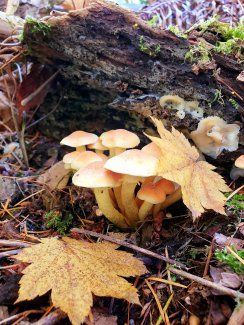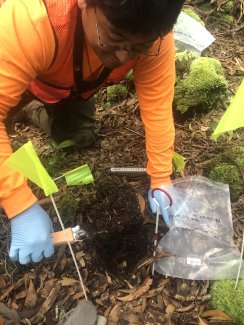Soil Microbes

Fungi on the forest floor at a field site in Domain 16. Photo credit: Jessica Timber Zemaitis
Soil microbial communities form the foundation of the terrestrial ecosystem and are critical drivers of biogeochemical processes. Microbes play an essential role in nutrient cycling and soil fertility and influence global climate, water quality, and atmospheric composition. A few grams of soil may contain billions of microorganisms, including bacteria, archaea, and fungi. These organisms perform many tasks in the ecosystem, including:
- Decomposition of organic matter to make carbon, nutrients, and energy available for plant growth
- Converting atmospheric nitrogen into nitrogen-containing compounds that plants can use
- Breaking down non-organic soil components and improving soil structure
- Breaking down pollutants in the environment into less toxic components
- Regulating carbon stocks by fixing carbon and storing it in the soil
- Binding soil particles to improve water infiltration and water-holding ability
Microbes also directly impact the health of plants and animals. Some are pathogens, causing diseases in susceptible plant or animal species. Other microbes provide a protective function or suppress pathogenic bacteria.
There are still many questions about how bacterial abundance, type, and diversity are related to ecosystem health, productivity, and function. There are complex interrelationships between climate, ecosystem function, and microbial communities. However, most climate change models relegate microbial inputs to "black box" status. More research is needed to better understand how microbes are both responding to and driving environmental and climate changes from local to global scales.
Looking at microbial communities in soil provides important insights into the overall health and productivity of the terrestrial ecosystem. At terrestrial field sites, soil cores are collected for microbial analysis to determine the overall composition and abundance of microbial communities. Soil cores are separated into different horizons, or layers, to determine how microbial communities vary across the depth of the sample and between soil layers with different characteristics. Soil samples generate several different data products, including microbial biomass, microbe community composition, microbe group abundance, microbe metagenome sequences, and microbe marker gene sequences. These data products will help researchers better understand the drivers of microbial diversity and composition in relation to biogeochemistry; how microbial communities differ across ecosystems and how they are changing over time; and the relationships between soil microbes and plants, small mammals, insects, and various pathogens.
Sampling Design and Methods
Soil microbial samples are collected as part of a soil sampling bout at all terrestrial field sites. There are two main types of sampling bouts: non-coordinated and coordinated. A non-coordinated bout occurs most years at a site and consists primarily of microbial sampling, while a coordinated bout occurs every five years at a site and includes additional soil biogeochemical and isotopic measurements, as well as coordinated plant biogeochemical measurements.
Three soil cores are taken from ten pre-determined soil plots at each field site during each sampling bout, including four plots within the tower airshed and six plots distributed throughout the field site. Plots are selected to reflect the dominant vegetation types at each site. Sampling bouts occur up to three times per year at each field site. One sampling event occurs at all sites during the period of "peak greenness." For most sites (excluding sites with very short growing seasons), two additional sampling events occur during seasonal transitions. For temperature-driven sites, these samples capture snowmelt/thaw in the spring and plant senescence in the fall. For precipitation-driven sites, these windows capture the onset of the wet or dry season. Timing of sampling bouts is specific to each site. Within each sampling event, samples from all plots within the field site are typically collected within 14 calendar days.
Microbial analysis (including microbe community composition, microbe group abundance, and genetic analysis) is conducted on all core site samples and during coordinated bouts. Metagenomic analysis is conducted once per year on composite, plot-level samples collected at peak greenness. Sampling occurs every year at all sites during coordinated bouts.
Microbial biomass measurements are conducted every five years at a site during coordinated bouts and for all sampling events of that year. Samples are collected at all soil plots and on each soil horizon encountered (organic and/or mineral). Microbial archive subsamples are collected during all sampling events at all sites and soil plots. During a non-coordinated bout, samples are collected for the surface horizon, while during a coordinated bout samples are collected from each soil horizon encountered (organic and/or mineral).
Collection

Shea Uehana sampling soil microbes at the PUUM field site, D20
Soil microbe samples are collected at all terrestrial field sites. Samples are collected in conjunction with soil biogeochemical sample collection using protocols outlined by the Soil Science Society of America in Methods of Soil Analysis (Sparks et al., 1996) as well as Standard Soil Methods for Long-Term Ecological Research (Robertson et al., 1999).
Soil samples are collected at randomly assigned locations within the soil sampling plots located across each NEON site. Typically, the soil is collected using a 1.5-2.5 in. diameter coring device, with the exact collection device being dictated by the local soil conditions such as rockiness or clay content. Soil sampling is conducted to a maximum depth of 30 cm wherever possible. Cores are taken from undisturbed soil and each sampled location is tracked to prevent future sampling from that exact location.
This coring method allows soil to be separated by soil horizon (horizontal layers with distinct physical, chemical, and biological characteristics) for microbial and biogeochemical analyses. Organic and mineral horizons are separated prior to analysis, allowing researchers to determine how microbial communities differ at different depths, soil types, and soil horizons.
During each sampling bout, additional soil measurements are also taken, including:
- Soil temperature
- Litter depth
- Soil moisture
- Soil pH
Soil cores are separated by horizon and homogenized, and rocks, roots, and organic debris are removed. The homogenized soil is divided into subsamples for separate microbial and chemical analyses. Samples for microbial analysis are prepared in two ways:
- Genetic subsamples, used for microbial genetic and metagenomic analysis, microbe community composition and abundances, or archiving, are made and frozen in the field and then shipped on dry ice to the analytic laboratory or archive facility.
- Non-genetic subsamples, used for microbial biomass analysis, are generated in the lab with a subset of soil from each horizon. Mineral soils are sieved, and organic soils are re-picked to remove remaining rocks, roots, and non-soil material. 5-10 g of this collected soil is transferred to a sterile container, kept field moist, frozen, and shipped on dry ice.
Processing and Lab Analysis
Once microbial samples have been collected in the field, they are frozen and sent to an external laboratory for further analysis. Samples are minimally processed in the field and must be sealed and kept in sterile conditions to prevent cross-contamination from other microbes while in storage or transit. Once shipped to the analytical facility, samples are further prepared for laboratory analysis and DNA is extracted from the homogenized soil subsamples.
DNA extracted from the genetic subsamples is used for generating marker gene sequencing and taxonomic data as well as for quantitative polymerase chain reaction (qPCR) analysis using primer sets targeting the ribosomal RNA gene. These analyses provide data for microbe community composition, raw sequencing data, and microbe group abundances.
DNA extracted from the composite subsamples is used for shotgun metagenome sequencing and produces raw sequence data. These samples are freeze-dried and prepared at the analytical facility. High-throughput phospholipid fatty acid (PLFA) analysis is used to extract the total phospholipid content of the soil sample, which acts as a proxy for quantifying total microbial biomass in soils. Gas Chromatography analysis is used to quantify discrete lipid molecules and to estimate total lipid abundances.
Laboratory data are uploaded to NEON via an automated ingest process, which does basic QC testing and acceptance. Accepted data are then are published and available for download through the NEON data portal.
Data Products
Soil microbe data includes:
- Soil Microbe Biomass (DP1.10104.001)
- Soil Physical and Chemical Properties, Periodic (DP1.10086.001)
- Soil Microbe Marker Gene Sequences (DP1.10108.001)
- Soil Microbe Community Composition (DP1.10081.001)
- Soil Microbe Metagenome Sequences (DP1.10107.001)
Samples for chemical and physical analysis of soil are collected concurrently with soil microbial samples. Closely related data products include:
- Soil Stable Isotopes (Distributed Periodic) (DP1.10100.001)
- Soil Inorganic Nitrogen Pools and Transformations (DP1.10080.001)
- Soil Physical Properties (Distributed Periodic) (DP1.10086.001)
- Soil Chemical Properties (Distributed Periodic) (DP1.10078.001)
Archival Samples
Archival soil samples collected from NEON terrestrial field sites are available from the NEON Biorepository. Specimen collection of archive samples may occur annually or once every five years, in tandem with the coordinated measurements of carbon and nutrient cycling. Both organic and mineral horizons are archived, if present at the site location.
| Types of Samples | Storage Condition | Storage Container | Quantity Archived (Annually) † | Expected Sampling Frequency | Link to the Collection |
|---|---|---|---|---|---|
| Soil, air-dried | dry | 250 mL glass jars | 350 to 450 samples | only collected at sites performing coordinated bouts | Soil Collection (Distributed Periodic) (NEON-SOIC-DP) |
| Soil, frozen | -80 °C or -196 °C | 2 oz. WhirlPak, 50 mL conical tubes, or 5 mL cryovials | 19,000 to 21,000 | annually at all terrestrial sites | Soil Microbe Collection (Bulk Subsamples) (NEON-SOMC-BS) |
| Genomic extracts, from soils | -80 °C | 96-well plates‡ | 2,300 to 3,000 extracts | annually at all terrestrial sites | Soil Microbe Collection (DNA Extracts) (NEON-SOMC-DNA) |
† Quantities represented in this table are annual quantities expected from sampling conducted throughout the observatory during full Operations. Actual quantities may differ from these projections
‡ Quantities are number of samples (not number of well plates); up to 96 samples are contained on the same well plate